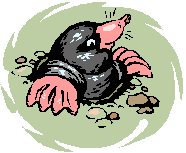|
|
|
|||||
|
|
||||||
|
||||||||||
|
Fast Growing Trees Fastest
Deciduous |
|
Faster
Deciduous |
|
Fast
Deciduous
Evergreen |
|
Fast Growing
Hedging Plants
Deciduous
Evergreen
Arborvitae
Douglas Fir |
|
Other unwelcome visitors: cats | foxes | frogs | moles :: pests and diseases | ants | aphids | blackspot | botrytis - gray mold | caterpillars | Japanese beetle larvae | leatherjackets | mealybugs | powdery mildew | red spider mite | rust | slugs and snails | vine weevils | whitefly |
|
|

The battle between moles and gardeners is a long running one and likely to continue as long as there are moles and gardeners. Moles can spoil lawns and their runs can undermine plants in borders. They spend most of their life underground and a single family can occupy up to half an acre of land. Burrowing activity is at a peak in the spring while the parents find food for the new litter of baby moles (can't find what a baby mole is called - think it might be a kitten).
Moles are carnivores and feed on worms and grubs that they find in the soil, they don't feed on plants and damage them only coincidentally as they burrow past.
Traditionally moles were removed from a site by a mole catcher in a battle of wits whereby he inserted traps into runs in the evening and returned the next day to see how many he had caught. This is still an option for gardeners though many people find it distasteful today as the mole is killed. There is also the disadvantage that the garden is now missing any resident moles and the chances are that another family will move in to take the place of the deceased ones!
There are a whole range of chemical deterrents available that can be put down the mole run such as:
|
Castor oil can also be used on the ground. When the moles food is seasoned with castor oil, they will go elsewhere for meals. (Wouldn't you?) Mix up a spray of 3 parts castor oil to 1 part dish detergent; use 4 tablespoons of this concoction in a gallon of water, and soak the tunnels and the entrances. Check your soil for the presence of pests; if you have a lot of moles, you probably have an oversupply of grubs and bugs.
More modern methods involve the use of a sonic deterrent, which emit bursts of sounds on a regular basis that the moles find off putting and leave. The results of this method however are not instant and devices need to be kept running for 4 to 6 months. There is also the problem that when you stop, the moles may come back, the devices are not cheap either, particularly if you need several to cover a large area.
|
|
|
About us. General queries and emails to |
|
Copyright © Paul Ward 2000 - 2012 |